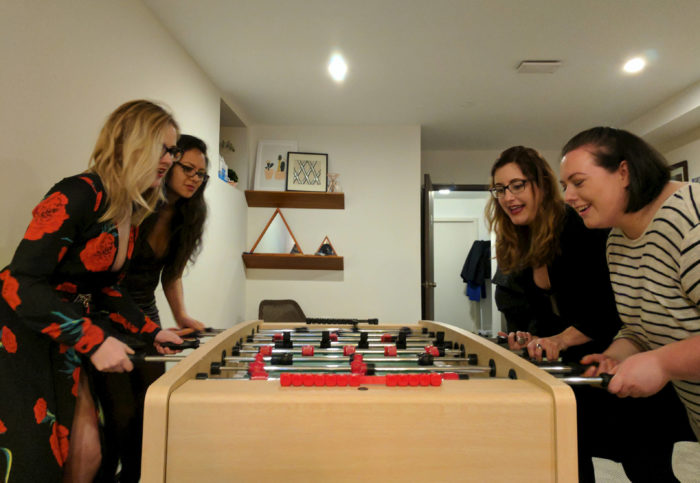Why Dorms for Grownups Are a New Way of Life
In a sequel to the co-working boom, co-living catches on in Brooklyn, and not for millennials only
A game of foosball on New Year's Eve at Common Pacific in Crown Heights (All photos courtesy of Common)
If you think applying to Stanford or MIT is a long shot, consider the odds of landing a spot in a Brooklyn co-living residence. Common, the company now operating six co-living facilities in the borough, recently received more than 15,000 applications for about 300 available rooms in three of the cities it serves: New York, San Francisco, and Washington, D.C. Why the demand? Co-living, essentially the residential version of the co-working trend, offers dorm-like, amenity-filled living that’s particularly attractive to millennials. The apartments come pre-stocked with furniture, appliances, fast WiFi, and lots of prospective friends.
John Bogil, 24, has shared a giant living room, kitchen, basement, and backyard with nine other people since moving into a Crown Heights facility called Common Albany a year ago. Although it sounds crowded, Bogil enjoys the company. “It’s awesome. I’ve made friends for life,” Bogil said. Common, launched in 2015, is Manhattan-based but has found fertile ground in Brooklyn. The growing portfolio in the borough includes the newly built Common Baltic in Boerum Hill, which offers co-living spaces as well as traditional apartments. The rent varies by neighborhood, with spaces in Crown Heights starting at $1,475 and Boerum Hill spots going for $2,143 and up.

On the roof deck at Common Herkimer in Crown Heights
Tenants have their own private bedrooms, many with private baths, but share the living room and kitchen as well as amenity spaces including lounges, fitness rooms, roof decks, dining rooms and work spaces. Convenience is a major selling point: the suites in a Common building come fully furnished with beds, dressers, couches, tables and chairs, a TV, towels and sheets, and a weekly cleaning service. Many of the issues that traditional roommates wind up fighting about have been taken off the table, like Real World with less drama.
Common was launched by Brad Hargreaves, who earlier had co-founded General Assembly, now a global educational company with campuses in 15 cities. Like many entrepreneurs, Hargreaves was looking to solve a problem. When the Yale grad first moved to New York City, he looked for an available room in an apartment on Craigslist and found the process cumbersome. “Common offers an alternative to this,” he said. “We make living with roommates better, more convenient, and more efficient.”

A rendering of the new Common Baltic in Boerum Hill
With young people increasingly crowding certain urban areas, the idea of a starter apartment is changing. While rents in Brooklyn have eased lately, thanks in part to new construction, the median rent is a daunting $2,785. With rents like those, some 76% of people 21 to 34 years old say they’ve made compromises to find a place to live, including living with roommates, according to the NHP Foundation, a group advocating affordable housing.
“Co-living has proven to be more than a passing trend,” said Hargreaves. “The response to opening our first home in Brooklyn was so strong that we were able to rapidly expand in the borough as well as into San Francisco and Washington, D.C. We now have nine homes on two coasts and are actively looking at new homes and new cities.” Common chooses its spots carefully, aiming to balance affordability and urban amenities. “We look to open in neighborhoods where there’s access to public transit and great local retail for our members to explore and enjoy,” said Hargreaves.
Common has the financial fuel to grow much more. The company has raised more than $23 million in two rounds of financing from 15 investors. The budding co-living industry now has multiple competitors as well, including WeLive, HubHaus, Node, and Krash. In Long Island City, a co-living company called Ollie plans to operate what it calls the largest co-living facility in North America, occupying 13 of the 42 floors in a new skyscraper.

Wine and painting night at Common Pacific in Crown Heights
While much of the allure of co-living is practical, many residents appreciate having the company, which in a cosmopolitan place like Brooklyn creates diverse collections of roommates. “I really appreciate the exposure to different peoples, ideas and cultures,” said Bogil. “I’ve learned so much about Australian politics and South African sports, for example, which might sound like useless info on the surface, but it helps me to learn about the world in a way that I never would normally. It makes the world feel smaller.” More than 70% of Common members are on 12-month leases but most stay longer than a year.
While typical co-living residents are in their 20s, the format could work for older adults as well, once the format goes mainstream. “There is growing interest in more communal types of living environments of the type offered by Common,” said David Reiss, an attorney and professor of real estate at Brooklyn Law School. “Co-living appeals to different people and our membership is diverse,” Hargreaves said. “We have young professionals, married couples, those moving to New York City for their first job, those moving from abroad, and ranging in their early 20s into their 30s and 40s.”
Could co-living even become a trend among baby boomers? Some experts think so, with many of the 75 million boomers in the U.S. looking for ways to make up for shortfalls in their retirement savings. “There’s an emerging realization that if you can’t afford retirement as a solo project, then there are other ways to get there that aren’t that painful,” said gerontologist and consultant Ken Dychtwald, San Francisco-based president of the firm Age Wave. In a survey, 27% of the respondents age 50 years and older said that they would consider renting a room for short- or long term stays, and 28% said they would consider a housemate, according to a Merrill Lynch/Age Wave study. “People are living with roommates for longer and later into their lives, especially in cities,” said Hargreaves. “Living in Common means that you won’t only know your neighbors but you’ll have a group of people you can laugh, cry, and kick back with, all next door.” Sounds a bit like Real World with grey hair.













